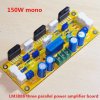After seeing Amir's review of the excellent $1,300 Neurochrome Modulus-286 (kit) amplifier:

and a new thread started today by the owner of an Akitika GT-102 ($314 kit, $488 assembled):

- and after considering the purchase of a $165 Chinese LM3886 amplifier with balanced XLR input:

I realized that I had not been aware of this family of Class AB chip-amps. From what I could find on the internet, the LM3886 is a low distortion, fairly high output and low distortion op-amp that required careful implementation. If not engineereed properly, LM386-based amplifiers can apparently cause problems including severe distortion, particularly at low frequencies, when driving 4Ω speakers.
Tom Christiansen, the owner of Neurochrome, is an electronics engineer who built the kit for Amir to test, and actually worked in op-amp design at Texas Instruments/National Semiconductor. He has this to say about the LM3886:
Like Class-D amplifiers, a decent chip is only a start. I am aware that it takes good engineering and proper implementation to make a good audio amplifier. Look at the dizzying array of LM3886 modules at this image-based search page. I wonder how many of them are "well-engineered"? I didn't take time to dredge through posts at the various DIY audio forums, but there is a long history of DIY "gain-clone" LM3886-based amplifiers, and I can only assume that there is a wide variation in reliability, consistency and quality of the LM3886 modules.
Although I considered the above cheap Chinese LM3886 amplifier with its balanced XLR inputs as a backup to my soon-to-be-completed ICEpower 200asx/200AS Ghent audio balanced XLR amp, I decided to stick with a RCA input TDA7498E Class-D amp for backup.
I'll be interested to follow any discussion of this by ASR regulars who are familiar with this class of amplifiers.
It would be interesting if Amir could test the Chinese balanced XLR version, because if it performs decently, it would be an excellent choice for those who want a medium-power, budget Class AB amp to connect via XLR to a USB DAC.
and a new thread started today by the owner of an Akitika GT-102 ($314 kit, $488 assembled):
- and after considering the purchase of a $165 Chinese LM3886 amplifier with balanced XLR input:
I realized that I had not been aware of this family of Class AB chip-amps. From what I could find on the internet, the LM3886 is a low distortion, fairly high output and low distortion op-amp that required careful implementation. If not engineereed properly, LM386-based amplifiers can apparently cause problems including severe distortion, particularly at low frequencies, when driving 4Ω speakers.
Tom Christiansen, the owner of Neurochrome, is an electronics engineer who built the kit for Amir to test, and actually worked in op-amp design at Texas Instruments/National Semiconductor. He has this to say about the LM3886:
The National Semiconductor (now Texas Instruments) LM3886 chip amp is a pretty nice little chip. With headline specs touting nearly 70 W of output power at 0.03 % THD and the ability to source over 11 A, what’s not to like? Well, as with any high-performance IC, it takes some engineering to get the circuit to live up to the data sheet specs. In particular with power op-amps, such as LM3886, the PCB layout or point-to-point wiring routes make a significant difference in the circuit performance. Judging by the chatter on the DIY Audio Chip Amps Forum, the main challenges for designers appear to be stability, bypassing, grounding, layout, and thermal design. My intent with these pages is to explore some of the common pitfalls and provide a design guide to a successful LM3886 design.
Like Class-D amplifiers, a decent chip is only a start. I am aware that it takes good engineering and proper implementation to make a good audio amplifier. Look at the dizzying array of LM3886 modules at this image-based search page. I wonder how many of them are "well-engineered"? I didn't take time to dredge through posts at the various DIY audio forums, but there is a long history of DIY "gain-clone" LM3886-based amplifiers, and I can only assume that there is a wide variation in reliability, consistency and quality of the LM3886 modules.
Although I considered the above cheap Chinese LM3886 amplifier with its balanced XLR inputs as a backup to my soon-to-be-completed ICEpower 200asx/200AS Ghent audio balanced XLR amp, I decided to stick with a RCA input TDA7498E Class-D amp for backup.
I'll be interested to follow any discussion of this by ASR regulars who are familiar with this class of amplifiers.
It would be interesting if Amir could test the Chinese balanced XLR version, because if it performs decently, it would be an excellent choice for those who want a medium-power, budget Class AB amp to connect via XLR to a USB DAC.


